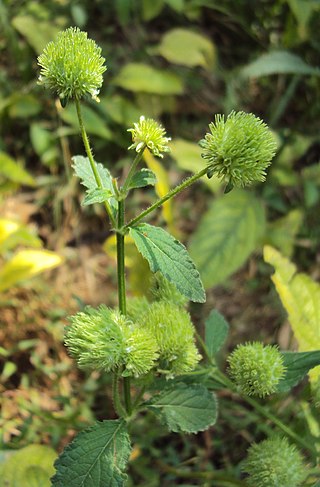
Herring are forage fish, mostly belonging to the family of Clupeidae.
The Agag gerbil is distributed mainly in southern Mauritania to northern Nigeria and Sudan. IUCN lists the junior synonyms Gerbillus cosensi and G. dalloni as critically endangered.

Kemp's gerbil is a species of rodent. Mammal Species of the World considers G. kempi and G. gambianus to be synonyms, however the IUCN has assessed each taxon as were they different species.

Hyptis is a genus of flowering plant in the family Lamiaceae. These plants, known commonly as bushmints, are widespread in tropical North and South America, as well as parts of West Africa. There are 150 species, which may be annual or perennial herb to shrub. Recently, several genera were segregated from Hyptis.
Mesosphaerum diversifolium is a species of flowering plant in the family Lamiaceae, formerly known as Hyptis diversifolia. Its natural habitat is subtropical or tropical moist montane forests only in Ecuador.
Hyptis florida is a species of flowering plant in the family Lamiaceae. It is found only in Ecuador. Its natural habitat is subtropical or tropical moist lowland forests.
Mesosphaerum pseudoglaucum is a species of flowering plant in the family Lamiaceae, formerly known as Hyptis pseudoglauca. It is found only in Ecuador. Its natural habitat is subtropical or tropical moist montane forests.

The Ugandan lowland shrew or Moon shrew, is a species of mammal in the family Soricidae. It is found in Kenya and Uganda. Its natural habitats are subtropical or tropical swamps and montane forests.

The Mount Cameroon forest shrew or arrogant shrew, is a species of mammal in the family Soricidae endemic to Cameroon. Its natural habitat is subtropical or tropical moist montane forests.

Condea emoryi, the desert lavender, is a large, multi-stemmed shrub species of flowering plant in Lamiaceae, the mint family.

Hyptis alata, the musky mint or clustered bushmint, is a shrub species of flowering plant in the Lamiaceae, the mint family. The genus Hyptis is commonly known as the bushmints. It is a native species throughout the southeastern United States from Texas to North Carolina, as well as in Cuba, Argentina, southern Brazil, and Paraguay. It is found in wetlands, prairies, pond margins and wet flatwoods. Hyptis alata is the southeastern United States analog to the Southwestern deserts H. emoryi, the desert lavender.USDA: NRCS: Plants Profile Hyptis alata
- Hyptis alata subsp. alata - United States and Cuba
- Hyptis alata subsp. rugosula(Briq.) Harley - South America
Hyptis crenata, the Brazilian mint, is a shrub species of flowering plant in the family Lamiaceae, native to Bolivia and Brazil. The genus Hyptis is commonly known as the bushmints. It is traditionally used for pain relief in Brazil.

The World's 25 Most Endangered Primates is a list of highly endangered primate species selected and published by the International Union for Conservation of Nature (IUCN) Species Survival Commission (SSC) Primate Specialist Group (PSG), the International Primatological Society (IPS), Global Wildlife Conservation (GWC), and Bristol Zoological Society (BZS). The IUCN/SSC PSG worked with Conservation International (CI) to start the list in 2000, but in 2002, during the 19th Congress of the International Primatological Society, primatologists reviewed and debated the list, resulting in the 2002–2004 revision and the endorsement of the IPS. The publication was a joint project between the three conservation organizations until the 2012–2014 list when BZS was added as a publisher. The 2018–2020 list was the first time Conservation International was not among the publishers, replaced instead by GWC. The list has been revised every two years following the biannual Congress of the IPS. Starting with the 2004–2006 report, the title changed to "Primates in Peril: The World's 25 Most Endangered Primates". That same year, the list began to provide information about each species, including their conservation status and the threats they face in the wild. The species text is written in collaboration with experts from the field, with 60 people contributing to the 2006–2008 report and 85 people contributing to the 2008–2010 report. The 2004–2006 and 2006–2008 reports were published in the IUCN/SSC PSG journal Primate Conservation,, since then they have been published as independent publications.

Orphanostigma abruptalis is a moth of the family Crambidae. The species was first described by Francis Walker in 1859. It occurs in the tropics of the Old World from Africa to Australia.

Pyrausta phoenicealis, the perilla leaf moth, is a moth of the family Crambidae described by Jacob Hübner in 1818. It is found worldwide, including the Americas, Africa, Australia and Asia.

Hyptis capitata, also known as false ironwort or knobweed, is a species of erect annual shrubs, of the plant family Lamiaceae. It is native to Florida, Mexico, Central America, the West Indies, and South America but naturalized in Australia, Southeast Asia, and some tropical islands. The plants grow up to a height of 1.5 meters. Crushed leaves are applied to cuts. It is considered a weed in many places.

Hyptis brevipes is a species of flowering plant in the genus Hyptis. These plants known commonly as lesser roundweed, nanto-iganigakusa (Taiwan), genggeyan and kaneja (Indonesia), sawi hutan (Malaysia), ortela-brava and fazendeiro (Brazil). Hyptis brevipes is an erect annual plant up to 1 m high with the typical square stem of a labiate, often densely hairy but sometimes less so. Leaves are also normally coarsely hairy on both surfaces, opposite, narrowly ovate or lanceolate, 5–7 cm long, up to 2 cm wide, cuneate at the base, the margins irregularly serrate. The inflorescence is a dense raceme, almost globose, up to 14 mm diameter, on a peduncle about 1 cm long in the axils of most upper leaves. Corolla or petals are white, irregularly five-lobed, and about 5 mm long. The calyx, 4 mm long, also has five narrow, finely barbed lobes. Seeds are ovoid, up to 1 mm long, dark brown to black, obscurely striate, with a conspicuous scar.











